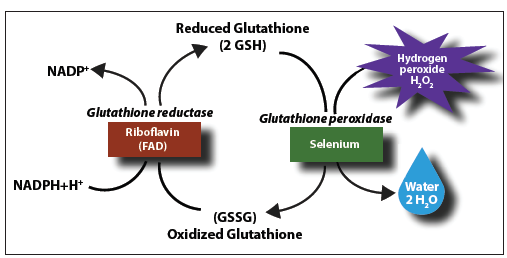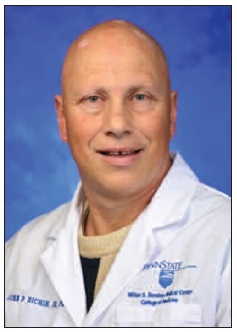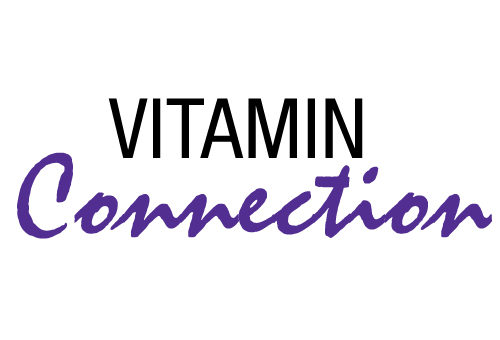It’s quite simple! According to the predominance of the scientific evidence, the higher the levels of glutathione in cells, on average, the longer the lifespan and the better health (1, 2).
Not only is glutathione the master antioxidant that recharges other antioxidants, it is the master detoxifier. Many of the pollutants that we are exposed to are activated in the body to become more reactive chemicals. The most important way that the body gets rid of these reactive toxic pollutants is by reacting them with glutathione. In addition to being the master antioxidant and master detoxifier, glutathione strengthens the immune system in several ways.
 Glutathione has at least 15 functions in the body. Glutathione’s role in health and disease was reviewed in the February 2011 issue of Natural Medicine Journal by Dean P. Jones, Ph.D., professor in the division of pulmonary medicine at Emory University (3). Dr. Jones notes that as a consequence of aging, lifestyle, diet and disease, a gap can develop between the needs and availability of glutathione.
Glutathione has at least 15 functions in the body. Glutathione’s role in health and disease was reviewed in the February 2011 issue of Natural Medicine Journal by Dean P. Jones, Ph.D., professor in the division of pulmonary medicine at Emory University (3). Dr. Jones notes that as a consequence of aging, lifestyle, diet and disease, a gap can develop between the needs and availability of glutathione.
Evidence suggests that glutathione is produced within every cell of the body, but the liver—our main detoxifying organ—produces glutathione for export to other tissues. Knowing the best ways to optimize glutathione levels in tissues and blood is important. Glutathione levels within cells need to be higher than those outside of cells. Nevertheless, the glutathione levels in the fluids surrounding cells are important because they protect the cell membranes.
In January, we discussed selenium and the reduction of cancer biomarkers with John P. Richie, Jr., Ph.D. (4). Dr. Richie’s research focuses on the elucidation of factors that regulate cancer risk, including nutrition. He gives particular emphasis to factors related to the generation of and protection against oxidative damage such as selenium and glutathione. A major emphasis of Dr. Richie’s research is to examine the role of glutathione—the major endogenous antioxidant in nearly all cells and tissues—in protecting against oxidative damage during aging and its relationship with cancer development at numerous sites.
Just as our chat on selenium and cancer risk was concluding, another of Dr. Richie’s important research articles on glutathione was published and he agreed to discuss that research with us as well. It has been quite some time since I have discussed glutathione in this column, so we’ll try to start near the beginning. The major reason that I haven’t discussed this “master antioxidant” lately is that there has been a question regarding the biochemistry of glutathione in some studies. This issue had to be resolved. This is what Dr. Richie has done in his most recent research report.
Dr. Richie is a professor of public health sciences and pharmacology at Penn State College of Medicine, State College, PA. He received his Ph.D. in biochemistry from the University of Louisville in 1985. After additional postdoctoral training in pharmacology/toxicology, he joined the American Health Foundation (Institute for Cancer Prevention) in Valhalla, NY, where he developed and led a research program on cancer susceptibility and aging as part of their NCI-designated Cancer Center. In 2004, he moved his laboratory to the Penn State University College of Medicine where he is a member of department of public health sciences and the Penn State Hershey Cancer Institute.
Dr. Richie’s research focuses on the elucidation of factors that link the biological aging process to increased risk for chronic diseases including cancer. Using an interdisciplinary research approach, the aim is to identify mechanistic factors, acting alone and in combination, which impact aging and cancer risk, with the ultimate goal of designing and developing targeted prevention strategies. Major areas of focus include diet and race/ethnicity with a particular emphasis on tobacco-related cancers. Specific mechanisms under investigation include critical pathways involved in the generation of and protection against oxidative stress.
Dr. Richie has researched glutathione for more than 30 years, including its role in protecting against oxidative damage during aging and the development of cancer at numerous sites in the body. Dr. Richie’s glutathione research focuses on the factors that regulate glutathione, oxidative stress and cancer risk in individuals and in various populations.
Passwater: Dr. Richie, we have long called l-glutathione (GSH) “The Master Antioxidant.” Why?
Richie: Antioxidants play an important role in helping to protect cells and tissues against oxidative damage. While there are many antioxidant compounds in our diet, GSH (the form that we normally call l-glutathione is the reduced form of GSH) is the only antioxidant that is produced in all of our cells for the purpose of protecting us from oxidants and other toxic challenges. Having evolved to use GSH for this purpose, our cells have an entire array of enzyme systems designed to work with GSH for this purpose. Perhaps, most importantly, when GSH does its job in detoxifying oxidants, the end product—which is oxidized GSH and is written chemically as GSSH (also called glutathione disulfide)—is not itself harmful and is safely and quickly recycled back to GSH. This is not the case with many other antioxidants.
Also, it has been recently recognized that GSH does more than just act to destroy free radicals and other toxins; it also serves as a critical signaling mechanism within cells by sensing the presence of oxidative stresses and, in turn, turning on other important protective systems in the cell. For these reasons, GSH can be considered the primary or “master” antioxidant that our bodies were designed to use for protection.
Passwater: I’ve always called GSH the “foot-soldier” of our antioxidant defenses. It seems that GSH sacrifices itself to regenerate other antioxidants and a large amount of GSH is consumed as a direct antioxidant and also in recycling other antioxidants.
Richie: Well, that is true, but we must keep in mind that most of our cells have the ability to regenerate GSH after it does its job. This is critical because it allows for a constant production of GSH supplying the needs of all of our tissues. Cells’ GSH production is dependent upon the availability of the necessary precursors that are provided in our diets. Thus, GSH levels can become depleted as a result of poor diets or periods of fasting (for example, while we are sleeping). While the liver is designed to help prevent GSH loss in all of our cells and tissues during short periods of inadequate dietary intake, GSH depletion can result from prolonged periods of poor nutrition. In addition, GSH can also become depleted as a result of toxic exposure, certain disease processes and old age. Consequently, it is difficult to assess exactly how much GSH our bodies require as this amount can differ from person to person and can change from day to day.
Passwater: Usually GSH supplements are found in the amino acid section of stores, but l-glutathione technically is neither an amino acid nor a protein. What is GSH?
Richie: GSH is technically a peptide, which is like a very small protein, and it is made up of three amino acids (cysteine, glutamic acid and glycine) that are linked together.
Passwater: The body makes GSH, therefore it is not a diet-essential nutrient. As you mentioned, GSH can be made in the body from the amino acids l-cysteine, l-glutamic acid and glycine. The sulfhydryl group (SH) of cysteine serves as a proton donor and is responsible for its biological activity. Cysteine is the rate-limiting factor in cellular GSH synthesis, since this amino acid is relatively rare in foods.
The body makes GSH in two adenosine triphosphate (ATP)-dependent steps:
• First, gamma-glutamylcysteine is synthesized from l-glutamate and cysteine via the enzyme gamma-glutamylcysteine synthetase. This reaction is the rate-limiting step in GSH synthesis.
• Second, glycine is added to the C-terminal of gamma-glutamylcysteine via the enzyme glutathione synthetase.
One can see that GSH production is complicated and can be limited. Does the body always make optimal amounts? If not, what can happen?
Richie: GSH production by cells can be limited due to the lack of precursors in the diet or during periods of increased utilization. For example, after we have not eaten for several hours, GSH production in many of our cells slows considerably. During these short periods, the liver—which has a greater capacity for recycling GSH precursors and synthesizing GSH for export to other tissues—can help prevent widespread GSH deficiencies in our body.
However, over the long term, dietary supply of adequate amounts of GSH precursors or GSH itself is required to prevent deficiency. If not corrected, GSH depletion leaves our cells and tissues at enhanced risk for damage due to toxins and toxicants in the environment. Long-term GSH depletion has been associated with increased susceptibility to many diseases and disorders including cancer.
Passwater: Can dietary supplements help make up the shortage?
Richie: Yes, supplementation is an effective way to help maintain optimal levels of GSH in our cells and tissues. To some extent, both GSH precursors as well as GSH itself can be effective.
Passwater: GSH functions by donating an electron to a free radical, peroxide or other oxidized species. In donating an electron, GSH itself becomes reactive, but readily reacts with another reactive GSH to form glutathione disulfide (GSSG).
A main action is reducing the disulfide bonds in cysteine units in proteins thus reducing the protein while GSH itself is oxidized to GSSH. What is the importance of this reaction?
Richie: That is correct; one function of GSH is to detoxify oxidants by donating an electron. The resulting “oxidized” form of GSH either reacts with another GSH molecule to form GSSG or with cysteine groups on cellular proteins to form “protein GSH mixed disulfides,” a process known as “protein glutathionylation.” This latter reaction can change the protein’s structure and function, which can, in turn, evoke a functional change within the cell. Indeed, protein glutathionylation reactions can result in a bolstering of the cell’s protective mechanisms, for example by enhancing GSH synthesis pathways.

|
| Figure 1: The Glutathione Redox Cycle. Reduced Glutathione (GSH) reduces oxidants with the aid of selenium-containing glutathione peroxidase (GPx), forming oxidized glutathione (GSSG) in the process. Glutathione reductase converts GSSH back to GSH to complete the cycle, which is repeated as needed. An alternative pathway for reducing GSSH utilizes thioredoxin reductase along with thioredoxin (Trx) and NADPH to reduce the disulfide bonds. |
Passwater: We mentioned that GSH reduces peroxides and other oxidative species. Enzymes of the GSH peroxidases family catalyze (facilitate) these reactions. This is of particular interest to both of us as selenium is involved as part of GSH peroxidases. Please explain to our readers how selenium is involved in GSH biochemistry.
Richie: Selenium, in the form of selenocysteine, is an essential component of several critical enzymes. These so-called “selenoproteins” can become depleted when the availability of selenium in the diet is limited. One such selenoprotein is glutathione peroxidase (GPx), an important enzyme that uses GSH to detoxify a variety of damaging peroxides and preventing lipid peroxidation in the cell (See Figure 1). Another selenium-containing enzyme, thioredoxin reductase, helps maintain GSH in its reduced and active states within the cell.
Passwater: We discussed how GSH can recycle other antioxidants. How about GSH? Can it be recycled?

|
| John P. Richie, Jr., Ph.D., professor of public health sciences and pharmacology |
Richie: Yes, as mentioned previously, one reason why GSH is so effective as an antioxidant is that its oxidized forms are easily recycled back to GSH through the use of highly efficient and ubiquitous enzymes. One main product of GSH oxidation is GSSG, a safe and relatively nontoxic chemical that is rapidly reduced back to two molecules of GSH by the enzyme “glutathione reductase.”
Passwater: Earlier, I mentioned that I had refrained from discussing GSH supplements for years because of a scientific uncertainty about its absorption when intact and ability to raise blood levels of GSH. A long-time researcher began to question the validity of his own research because he saw indications that the increase in blood levels he observed was obtained from the method of taking the blood samples. He saw indications that the procedure for drawing blood appeared to be causing the increase in blood GSH levels.
GSH supplements would seem to be the most efficient way to increase cellular levels of GSH because if significant amounts of GSH are absorbed intact and are biologically active and also if the digestion process breaks down additional amounts of the supplemental GSH into its precursors—which would then be also absorbed and available for recombination into GSH—the inter- and intracellular GSH transport mechanisms would be shifted in favor of increased cellular GSH.
Without the scientific issue of whether or not GSH was absorbed intact and biologically active being resolved, we often relied on proven indirect methods that included supplements that contained one or more of the GSH precursors and antioxidant supplements which help spare GSH by reducing the level of free radicals. Supplements such as NAC, lipoic acid and Pycnogenol are effective in this manner.
You have recently published your research on the validity of GSH supplements directly raising the body’s GSH levels. What can you tell us about this research?
Richie: Yes, the potential efficacy of oral GSH supplementation remained a point of controversy for many years. Contributing to the confusion was the common use of inadequate sample collection and processing procedures and methods of analysis of GSH and its various oxidation products in both laboratory and clinical studies.
Despite the methodological problems in the literature, results of well-conducted studies have demonstrated that supplementation with GSH can be an effective means of enhancing tissue GSH levels in laboratory animals.
However, questions regarding the mechanism of oral GSH supplementation remained. Was it absorbed intact or was it broken down in the gut to its component amino acids and resynthesized in cells?
More recent data have quite convincingly demonstrated that a substantial amount of GSH is directly absorbed and bioavailable. In fact, in some cases, the proteins responsible for GSH transport in the intestine have been identified. However, such data in humans have been lacking.
To help clarify this matter, we recently conducted a randomized, placebo-controlled, double blinded clinical trial of oral GSH supplementation. In this trial, subjects were placed on a regimen of either placebo, low-dose GSH (250 mg per day) or high-dose GSH (1,000 mg per day, as Setria from Kyowa Hakko) for six months (5). Results demonstrated that oral GSH supplementation was effective at enhancing body stores of GSH in a time- and dose-dependent fashion. Also of interest is that GSH supplementation resulted in a reduction of oxidized GSH levels in blood, suggestive of a reduction in levels of oxidative stress.
Passwater: What are your recommendations for taking l-glutathione supplements?
Richie: I am not a clinician and, as such, I avoid making clinical recommendations. However, I can say that our recent results suggest that oral GSH supplementation can be an effective means of increasing the body’s stores of GSH. As a result, GSH supplementation in the long run may prove to be an effective  means of reducing levels of chronic oxidative stress and its related disorders and diseases.
means of reducing levels of chronic oxidative stress and its related disorders and diseases.
Passwater: Dr. Richie, thanks for once again for sharing your research with us. WF
Dr. Richard Passwater is the author of more than 45 books and 500 articles on nutrition. Dr. Passwater has been WholeFoods Magazine’s science editor and author of this column since 1984. More information is available on his Web site, www.drpasswater.com.
References
1. H.R. Andersen et al., “Low Activity Of Superoxide Dismutase and High Activity of Glutathione Reductase in Erythrocytes from Centenarians,” Age Ageing 27 (5), 643–648 (1998).
2. C.A. Lang, et al., “High Blood Glutathione Levels Accompany Excellent Physical and Mental Health in Women Ages 60 to 103 Years,” J. Lab. Clin. Med. 140 (6), 380–381 (2002).
3. D.P. Jones, “The Health Dividend of Glutathione,” Natural Med. J. 3 (2), Feb. 2011, http://naturalmedicinejournal.com/journal/2011-02/health-dividend-glutathione, accessed Aug. 12, 2015.
4. R.A. Passwater, “Taking the Confusion Out of Selenium,” WholeFoods Magazine 38 (1), 44–45, 48 (2015), www.wholefoodsmagazine.com/columns/vitamin-connection/taking-confusion-out-selenium.
Published in WholeFoods Magazine, October 2015










